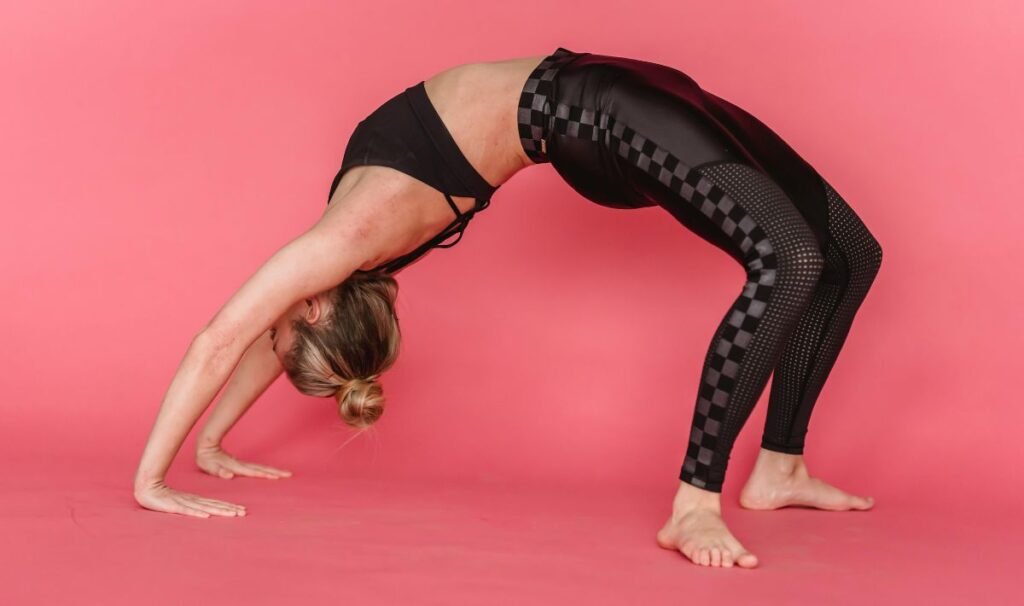Yoga is an incredible journey of self-discovery, strength, and flexibility. Among its many poses, Wild Thing, or Camatkarasana, stands out as a heart-opening and invigorating asana that challenges both your body and your mind. If you’ve ever seen someone effortlessly flow into this pose and wondered how to do it, you’re in the right place. In this post, we’ll cover everything you need to know about Wild Thing, including its steps, benefits, and how to incorporate it into your yoga practice.
What is Wild Thing (Camatkarasana)?
Wild Thing, also known as the Rockstar Yoga Pose, is a backbend that combines elements of strength, balance, and flexibility. The Sanskrit name, Camatkarasana, translates to “the ecstatic unfolding of the heart,” which perfectly captures the essence of this pose. It’s a playful, expansive movement that encourages you to open your chest and embrace a sense of freedom and joy.
Unlike some yoga poses that feel grounded and contained, Wild Thing invites you to let loose and celebrate the moment. But don’t be fooled—this pose requires a mix of stability and mobility, making it a rewarding challenge for yogis of all levels.
Benefits of Wild Thing
1. Heart-Opening and Emotional Release
Wild Thing is a powerful heart-opener, which helps release pent-up emotions and fosters a sense of emotional liberation. If you’ve been feeling stressed, anxious, or stuck, practicing this pose can feel like a breath of fresh air for your soul.
2. Strengthens Upper Body and Core
This pose engages your shoulders, arms, and core muscles. As you lift your chest and extend your arm, you’ll feel your upper body working hard to support you.
3. Improves Spinal Flexibility
Wild Thing involves a deep backbend, which enhances spinal flexibility and strengthens the muscles supporting your spine. It’s a fantastic way to counteract the effects of sitting for long periods.
4. Boosts Confidence
There’s something undeniably empowering about nailing this pose. It’s a reminder of your strength, grace, and resilience.
5. Enhances Balance and Coordination
Transitioning into Wild Thing requires balance and coordination, which improves your overall body awareness and control.
6. Energizes the Body
This pose stimulates your energy flow, leaving you feeling revitalized and ready to tackle whatever comes your way.
How to Do Wild Thing (Camatkarasana)
Ready to give Wild Thing a try? Follow these steps to flow into the pose with confidence:
Step-by-Step Guide
- Start in Downward Dog Begin in a strong Downward Facing Dog (Adho Mukha Svanasana), with your hands firmly planted on the mat and your hips lifted high. Ensure your spine is long and your core engaged.
- Shift to Side Plank Shift your weight onto your right hand and roll onto the outer edge of your right foot, stacking your left foot on top. Your body should form a straight line from head to heels.
- Flip Your Top Leg Bend your left knee and step your left foot behind you. Place it lightly on the mat for support.
- Lift Your Hips Press into your right hand and left foot to lift your hips high. Allow your chest to open toward the ceiling.
- Extend Your Arm Reach your left arm overhead in an expressive arc. Let your head gently tilt back as you gaze upward or toward your extended hand.
- Hold and Breathe Stay in the pose for 3-5 breaths, feeling the stretch through your chest and the strength in your supporting arm.
- Return to Downward Dog Slowly lower your hips and bring your left hand back to the mat. Step back into Downward Dog and repeat on the other side.
Tips for Success
- Engage Your Core: A strong core will help stabilize you as you transition into and hold the pose.
- Keep Your Wrist Safe: Press evenly through your fingers and avoid collapsing into your wrist.
- Breathe Deeply: Don’t forget to breathe! Deep breaths will help you stay focused and relaxed.
Modified Wild Thing Variations
If you’re new to Wild Thing or looking for a gentler option, try these modifications:
1. Use a Block for Support
Place a yoga block under your supporting hand to reduce the intensity of the pose.
2. Keep Both Feet on the Ground
Instead of flipping your top leg behind you, keep both feet grounded for extra stability.
3. Half Wild Thing
Skip the full backbend and simply lift your hips and extend your arm without going too deep into the pose.
Incorporating Wild Thing into Your Practice
Wild Thing Yoga Sequence
To fully experience the benefits of Wild Thing, try incorporating it into a flowing sequence:
- Warm-Up
- Cat-Cow Stretch (Marjaryasana-Bitilasana)
- Downward Dog
- Low Lunge (Anjaneyasana)
- Build Heat
- Plank Pose
- Side Plank
- Wild Thing (on both sides)
- Cool Down
- Child’s Pose (Balasana)
- Seated Forward Fold (Paschimottanasana)
- Supine Twist
When to Avoid Wild Thing
Wild Thing may not be suitable if you have:
- Wrist or shoulder injuries
- Low back pain or spinal issues
- Difficulty with balance
Always listen to your body and modify or skip poses as needed.
What Does a Wild Thing Pose Do for You?
Wild Thing is more than just a yoga pose—it’s an invitation to embrace your inner strength and joy. Physically, it builds strength, flexibility, and balance. Mentally, it encourages you to step out of your comfort zone and celebrate your progress, no matter where you are in your yoga journey.
FAQs about Wild Thing (Camatkarasana)
Q1: Is Wild Thing suitable for beginners?
A: While Wild Thing is more accessible to those with some yoga experience, beginners can try modified versions to build strength and confidence.
Q2: What muscles does Wild Thing work?
A: Wild Thing engages the shoulders, arms, core, glutes, and back muscles. It also opens the chest and stretches the hip flexors.
Q3: Can I practice Wild Thing with a wrist injury?
A: It’s best to avoid this pose if you have a wrist injury. You can try alternatives like Cobra Pose or Sphinx Pose to open the chest without putting pressure on your wrists.
Q4: How long should I hold Wild Thing?
A: Aim to hold the pose for 3-5 deep breaths on each side. Over time, you can increase the duration as your strength and flexibility improve.
Q5: What can I do if I feel unsteady in Wild Thing?
A: Focus on engaging your core and pressing firmly into your supporting hand and foot. You can also keep both feet on the ground for added stability.
Final Thoughts
Whether you’re an experienced yogi or just starting out, Wild Thing is a pose worth exploring. It’s playful, challenging, and deeply rewarding. Remember, yoga is about progress, not perfection. So, take your time, honor your body, and enjoy the journey.
Now it’s your turn to roll out your mat and give Wild Thing a try. Who knows? You might just discover a newfound sense of freedom and joy along the way!

Sonu is a passionate yoga teacher with over 6+ years of experience helping individuals find balance, strength, and inner peace through the transformative power of yoga. As the creator of Pure Yoga Vibes, Sonu shares expert insights, inspiring practices, and a wealth of knowledge to support your wellness journey. Dedicated to creating a space for growth and mindfulness, Sonu’s mission is to make yoga accessible and enjoyable for everyone. For inquiries or collaborations, feel free to reach out at contact@pureyogavibes.com.



